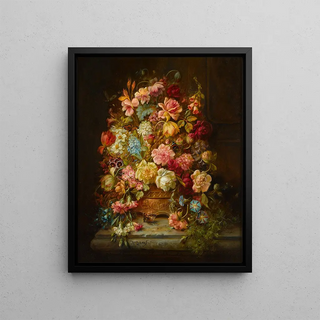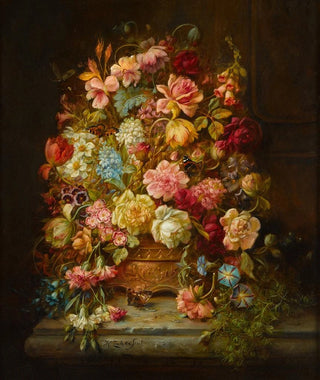Art print | A still life with flowers in a jardinière placed on a ledge - Hans Zatzka


View from behind

Frame (optional)
In the world of art, some works manage to capture the very essence of the fleeting beauty of nature. The art print Une nature morte avec des fleurs dans une jardinière posée sur un rebord - Hans Zatzka is a perfect example. This piece, imbued with delicacy and poetry, transports us to a universe where nature invites itself into our interiors. The flowers, carefully arranged, seem to tell a story—one of life, beauty, and fragility. Through this composition, Zatzka invites us to contemplate everyday life with a fresh perspective, to appreciate the small things that enhance our existence.
Style and uniqueness of the work
Zatzka's still life stands out for its refined approach and meticulous attention to detail. The vibrant colors of the flowers, ranging from bright roses to delicate violets, intertwine harmoniously, creating a lively tableau that captures the eye and the mind. The artist skillfully plays with light, highlighting textures and nuances, which gives the work unparalleled depth. Each petal, each leaf is rendered with remarkable precision, demonstrating Zatzka's exceptional craftsmanship. Furthermore, the choice of the jardinière, adorned with delicate motifs, adds an extra dimension to the composition, symbolizing the connection between the artificial and the natural. This work is not merely a static representation but an invitation to contemplation and daydreaming.
The artist and his influence
Hans Zatzka, an Austrian painter of the 19th century, is often regarded as a master of still life and genre scenes. His style, influenced by the Romantic movement, is characterized by a particular sensitivity to the beauty of the natural world. Zatzka succeeded in establishing himself through his ability to fuse realism with a touch of lyricism, creating works that resonate with palpable emotion. His influence extends beyond his contemporaries, inspiring many artists to explore themes of nature and everyday life. By incorporating elements of the popular culture of his time, Zatzka manages to establish

Matte finish

View from behind

Frame (optional)
In the world of art, some works manage to capture the very essence of the fleeting beauty of nature. The art print Une nature morte avec des fleurs dans une jardinière posée sur un rebord - Hans Zatzka is a perfect example. This piece, imbued with delicacy and poetry, transports us to a universe where nature invites itself into our interiors. The flowers, carefully arranged, seem to tell a story—one of life, beauty, and fragility. Through this composition, Zatzka invites us to contemplate everyday life with a fresh perspective, to appreciate the small things that enhance our existence.
Style and uniqueness of the work
Zatzka's still life stands out for its refined approach and meticulous attention to detail. The vibrant colors of the flowers, ranging from bright roses to delicate violets, intertwine harmoniously, creating a lively tableau that captures the eye and the mind. The artist skillfully plays with light, highlighting textures and nuances, which gives the work unparalleled depth. Each petal, each leaf is rendered with remarkable precision, demonstrating Zatzka's exceptional craftsmanship. Furthermore, the choice of the jardinière, adorned with delicate motifs, adds an extra dimension to the composition, symbolizing the connection between the artificial and the natural. This work is not merely a static representation but an invitation to contemplation and daydreaming.
The artist and his influence
Hans Zatzka, an Austrian painter of the 19th century, is often regarded as a master of still life and genre scenes. His style, influenced by the Romantic movement, is characterized by a particular sensitivity to the beauty of the natural world. Zatzka succeeded in establishing himself through his ability to fuse realism with a touch of lyricism, creating works that resonate with palpable emotion. His influence extends beyond his contemporaries, inspiring many artists to explore themes of nature and everyday life. By incorporating elements of the popular culture of his time, Zatzka manages to establish






